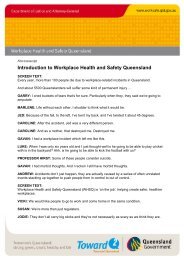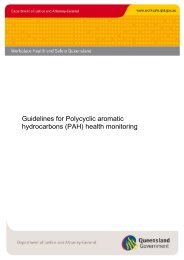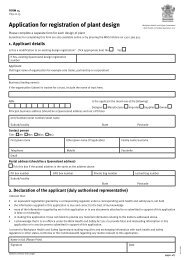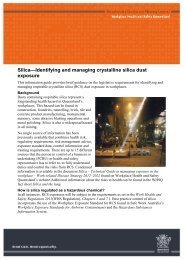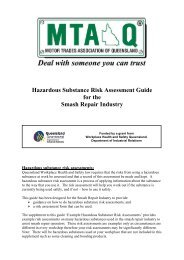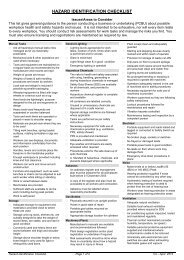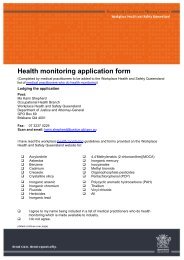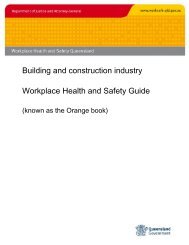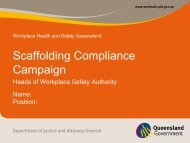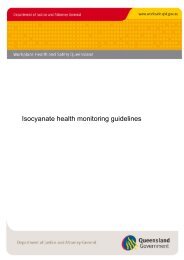Form 23 Notification of lead-risk work
Form 23 Notification of lead-risk work
Form 23 Notification of lead-risk work
You also want an ePaper? Increase the reach of your titles
YUMPU automatically turns print PDFs into web optimized ePapers that Google loves.
Declaration<br />
I have authority as the PCBU, or as their delegate, to complete and submit this notification<br />
The information in this notification is true and correct to the best <strong>of</strong> my knowledge<br />
I consent to Workplace Health and Safety Queensland making enquiries and exchanging information with WHS regulators in other states,<br />
territories or the Commonwealth regarding any matter relevant to this notification.<br />
Date: Name in full (please print): Signature:<br />
3. Describe the <strong>lead</strong> process carried out at the <strong>work</strong>place<br />
Tick more than one box if applicable<br />
<strong>work</strong> that exposes a person to <strong>lead</strong> dust or <strong>lead</strong> fumes arising from the manufacture or handling <strong>of</strong> dry <strong>lead</strong> compounds<br />
<strong>work</strong> in connection with the manufacture, assembly, handling or repair <strong>of</strong>, or parts <strong>of</strong>, batteries containing <strong>lead</strong> that involves the<br />
manipulation <strong>of</strong> dry <strong>lead</strong> compounds, or pasting or casting <strong>lead</strong><br />
breaking up or dismantling batteries containing <strong>lead</strong>, or sorting, packing and handling plates or other parts containing <strong>lead</strong> that are<br />
removed or recovered from the batteries<br />
spraying molten <strong>lead</strong> metal or alloys containing more than 5% by weight <strong>of</strong> <strong>lead</strong> metal<br />
melting or casting <strong>lead</strong> alloys containing more than 5% by weight <strong>of</strong> <strong>lead</strong> metal in which the temperature <strong>of</strong> the molten material exceeds<br />
450°C<br />
recovering <strong>lead</strong> from its ores, oxides or other compounds by thermal reduction process<br />
dry machine grinding, discing, buffing or cutting by power tools alloys containing more than 5% by weight <strong>of</strong> <strong>lead</strong> metal<br />
machine sanding or buffing surfaces coated with paint containing more than 1% by dry weight <strong>of</strong> <strong>lead</strong><br />
a process by which electric arc, oxyacetylene, oxy gas, plasma arc or a flame is applied for welding, cutting or cleaning, to the surface <strong>of</strong><br />
metal coated with <strong>lead</strong> or paint containing more than 1% by dry weight <strong>of</strong> <strong>lead</strong> metal<br />
radiator repairs that may cause exposure to <strong>lead</strong> dust or <strong>lead</strong> fumes<br />
fire assays if <strong>lead</strong>, <strong>lead</strong> compounds or <strong>lead</strong> alloys are used<br />
hand grinding and finishing <strong>lead</strong> or alloys containing more than 50% by dry weight <strong>of</strong> <strong>lead</strong><br />
spray painting with <strong>lead</strong> paint containing more than 1% by dry weight <strong>of</strong> <strong>lead</strong><br />
melting <strong>lead</strong> metal or alloys containing more than 50% by weight <strong>of</strong> <strong>lead</strong> metal if the exposed surface area <strong>of</strong> the molten material exceeds<br />
0.1 square metre and the temperature <strong>of</strong> the molten material does not exceed 450°C<br />
using a power tool, including abrasive blasting and high pressure water jets, to remove a surface coated with paint containing more than<br />
1% by dry weight <strong>of</strong> <strong>lead</strong> and handling waste containing <strong>lead</strong> resulting from the removal<br />
a process that exposes a person to <strong>lead</strong> dust or <strong>lead</strong> fumes arising from manufacturing or testing detonators or other explosives that<br />
contain <strong>lead</strong><br />
a process that exposes a person to <strong>lead</strong> dust or <strong>lead</strong> fumes arising from firing weapons at an indoor firing range<br />
foundry processes involving:<br />
(i)<br />
melting or casting <strong>lead</strong> alloys containing more than 1% by weight <strong>of</strong> <strong>lead</strong> metal in which the temperature <strong>of</strong> the molten material<br />
is more than 450°C or;<br />
(ii) dry machine grinding, discing, buffing or cutting by power tools <strong>lead</strong> alloys containing more than 1% by weight <strong>of</strong> <strong>lead</strong> metal<br />
a process decided by Workplace Health and Safety Queensland to be a <strong>lead</strong> process under regulation 393.<br />
4. Address <strong>of</strong> the <strong>work</strong>place for this <strong>lead</strong> <strong>risk</strong> <strong>work</strong><br />
(if different from the address <strong>of</strong> the PCBU)<br />
Building name/unit number/ street number/ street name:<br />
Suburb/locality: State: Postcode:<br />
(details continue over page)<br />
page 2 <strong>of</strong> 6<br />
JAG 12/4327





